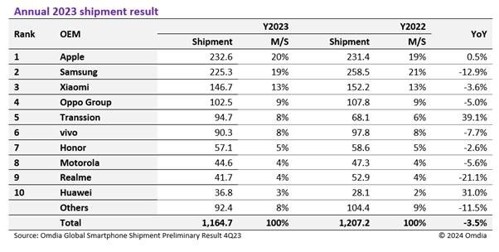This represents an 8.6% increase compared to Q422 and is the first quarter to see a significant increase since Q221. It is also an 8.6% increase compared to the previous quarter.
This growth signals an end to nine consecutive quarters of year-on-year declines in overall smartphone shipments and suggests that the industry is stabilising after a period of strong smartphone demand between 4Q20 and 3Q21, followed by supply chain problems in 2022.
Every major OEM recorded year-on-year growth other than Samsung, with Xiaomi, Transsion and Huawei all having significant growth of more than 20%. Despite this growth, Omdia research shows that the 2023 shipment total is now 1,164.7 million units, which represents a 3.5% fall from the 1,207.2 million total for 2022.
With the launch of the iPhone 15 series, Apple recorded the highest shipment total for Q423, with 78.7 million units. This is a 6.5% increase from the previous year, with the launch of the iPhone 14 series. This is the largest quarter for Apple since Q4 in 2021.
Samsung recorded 53.2 million unit shipments in the fourth quarter, a 9% fall from Q422. This means that Samsung is the only major smartphone OEM that has had lower shipments every quarter of 2023 than the same quarter in 2022. This resulting fall indicates that the 2023 total for Samsung is 12.9% lower than 2022 – 225.3 million in 2023 compared to 258.5 million in 2022.
According to Omdia, this could be the result of the collapse in demand for mid and low-end price tier phones, and therefore Samsung A-series phones, following a sustained period of high inflation and increasing cost of living globally.
Xiaomi has retained its shipment figures from the previous quarter, recording 41.2 million unit shipments in Q4. This is a slight 1.4% dip from the 41.8 million in Q423, but a significant 24.1% increase from Q422 and suggests that Xiaomi is recovering from a sustained period of falling market share, even among a falling overall market. By keeping these shipment numbers, Xiaomi is retaining and strengthening its position as the third largest OEMs globally.
Transsion Holding increased its shipments even further to 30.1 million in Q4, this is an increase of 11.1% from the previous quarter. This represents a staggering 74% increase from Q422 and makes Transsion the fourth largest OEM in 4Q23, having overtaken both vivo and Oppo and now leading them by more than 5 million units.
“The high growth of Transsion Holding in 2023 is mainly due to having solved inventory issues ahead of industry. Secondly, consumer downgrading caused by global inflation, as the products that Transsion Holding focuses on perfectly match the current needs. Thirdly, the active market expansion strategy that has taken place in 2023 has provided better market conditions for shipping,” said Zaker Li, Omdia Principal Analyst.
Oppo Group recorded 24.4 million shipments in Q423, an 8.3% fall from 3Q23. Despite this, it is a 2.8% increase from the 23.7 million at the end of 2022. This highlights that Oppo is now recovering its shipment numbers from a period of decline over 2022 and early 2023. It has, however, only begun recovering recently and not at the same rate as other OEMs, meaning it has lost market share and fallen from fourth to fifth in the overall smartphone OEM rankings.

Closely following Oppo is vivo recorded a 6.2% increase quarter-on-quarter to 24.0 million units.
Honor recorded 16.0 million unit shipments, a small 0.2 million or 1.3% increase from the previous quarter, but a large 1.9 million or 13.5% increase from the previous year.
The positions of 8th, 9th and 10th have seen a reshuffle in the last quarter of 2023. But all three of Motorola, Huawei and Realme were within 0.4 million units of one another.
Rising from 10th to 9th Huawei saw a 15% increased from Q3 from 10.7 million to 12.3 million units and reported a massive 64% increase from the 7.5 million units recorded in at the end of 2022. Huawei has in fact had year-on-year growth every quarter since Q322 and throughout all of 2023. As a result, its cumulative total for the year is 31% higher than the total for 2022 – increasing from 28.1 million to 36.8 million.
“The smartphone business in 2023 was determined by the products and regional markets each brand focuses on. While Apple, which concentrated on the premium market, recorded relatively good performance despite a decrease in overall market demand, the performance of major Chinese OEMs highly concentrated in the Chinese and Indian markets decreased significantly compared to the previous year due to the impact of the slump in smartphone demand in these two countries. Samsung, which has a high proportion of low- to mid-priced smartphones, also suffered a significant decline in shipments as its sales of mid- to low-priced smartphones were affected by the economic recession across the regions and was forced to give up its first place to Apple,” said Jusy Hong, Senior Research Manager, Omdia.
The smartphone market in 2024 is expected to return to growth compared to last year, but Omdia predicts that there is a possibility for it to turn to negative growth in the second half of the year compared to last year due to the economic recovery delay, geopolitical instability, and the growing used phone market.













